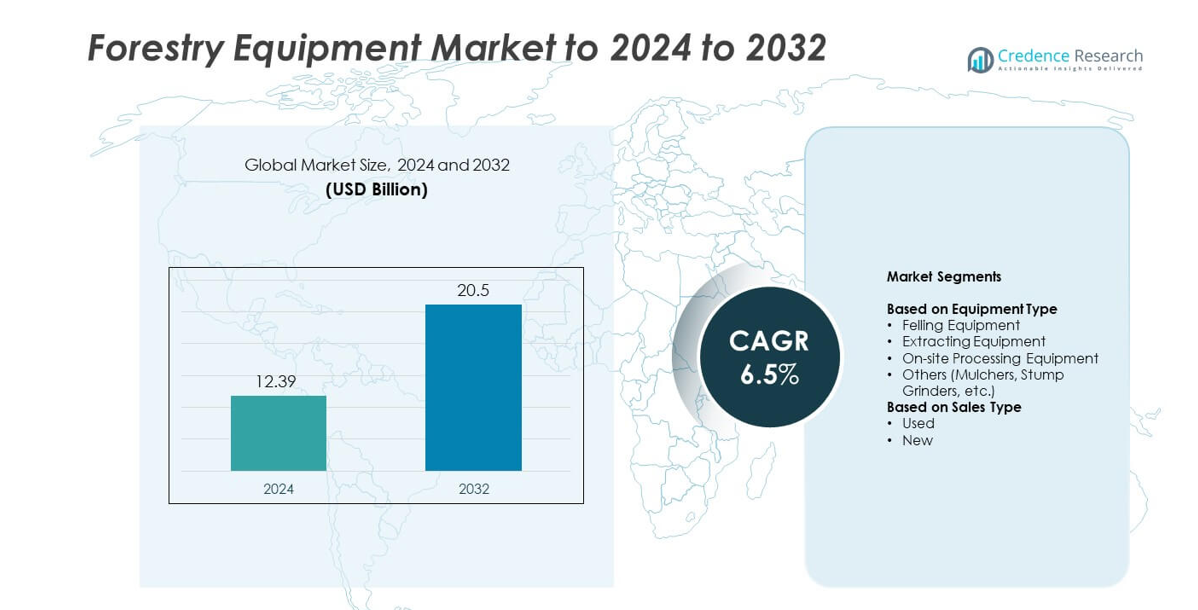1. Introduction
1.1. Report Description
1.2. Purpose of the Report
1.3. USP & Key Offerings
1.4. Key Benefits for Stakeholders
1.5. Target Audience
1.6. Report Scope
1.7. Regional Scope
2. Scope and Methodology
2.1. Objectives of the Study
2.2. Stakeholders
2.3. Data Sources
2.3.1. Primary Sources
2.3.2. Secondary Sources
2.4. Market Estimation
2.4.1. Bottom-Up Approach
2.4.2. Top-Down Approach
2.5. Forecasting Methodology
3. Executive Summary
4. Introduction
4.1. Overview
4.2. Key Industry Trends
5. Global Forestry Equipment Market
5.1. Market Overview
5.2. Market Performance
5.3. Impact of COVID-19
5.4. Market Forecast
6. Market Breakup by Equipment Type
6.1. Felling Equipment
6.1.1. Market Trends
6.1.2. Market Forecast
6.1.3. Revenue Share
6.1.4. Revenue Growth Opportunity
6.2. Extracting Equipment
6.2.1. Market Trends
6.2.2. Market Forecast
6.2.3. Revenue Share
6.2.4. Revenue Growth Opportunity
6.3. On-site Processing Equipment
6.3.1. Market Trends
6.3.2. Market Forecast
6.3.3. Revenue Share
6.3.4. Revenue Growth Opportunity
6.4. Others (Mulchers, Stump Grinders, etc.)
6.4.1. Market Trends
6.4.2. Market Forecast
6.4.3. Revenue Share
6.4.4. Revenue Growth Opportunity
7. Market Breakup by Sales Type
7.1. Used
7.1.1. Market Trends
7.1.2. Market Forecast
7.1.3. Revenue Share
7.1.4. Revenue Growth Opportunity
7.2. New
7.2.1. Market Trends
7.2.2. Market Forecast
7.2.3. Revenue Share
7.2.4. Revenue Growth Opportunity
8. Market Breakup by Region
8.1. North America
8.1.1. United States
8.1.1.1. Market Trends
8.1.1.2. Market Forecast
8.1.2. Canada
8.1.2.1. Market Trends
8.1.2.2. Market Forecast
8.2. Asia-Pacific
8.2.1. China
8.2.2. Japan
8.2.3. India
8.2.4. South Korea
8.2.5. Australia
8.2.6. Indonesia
8.2.7. Others
8.3. Europe
8.3.1. Germany
8.3.2. France
8.3.3. United Kingdom
8.3.4. Italy
8.3.5. Spain
8.3.6. Russia
8.3.7. Others
8.4. Latin America
8.4.1. Brazil
8.4.2. Mexico
8.4.3. Others
8.5. Middle East and Africa
8.5.1. Market Trends
8.5.2. Market Breakup by Country
8.5.3. Market Forecast
9. SWOT Analysis
9.1. Overview
9.2. Strengths
9.3. Weaknesses
9.4. Opportunities
9.5. Threats
10. Value Chain Analysis
11. Porter’s Five Forces Analysis
11.1. Overview
11.2. Bargaining Power of Buyers
11.3. Bargaining Power of Suppliers
11.4. Degree of Competition
11.5. Threat of New Entrants
11.6. Threat of Substitutes
12. Price Analysis
13. Competitive Landscape
13.1. Market Structure
13.2. Key Players
13.3. Profiles of Key Players
13.3.1. Deere & Company (U.S.)
13.3.1.1. Company Overview
13.3.1.2. Product Portfolio
13.3.1.3. Financials
13.3.1.4. SWOT Analysis
13.3.2. Komatsu Ltd. (Japan)
13.3.2.1. Company Overview
13.3.2.2. Product Portfolio
13.3.2.3. Financials
13.3.2.4. SWOT Analysis
13.3.3. STIHL HOLDING AG & Co. KG (Germany)
13.3.3.1. Company Overview
13.3.3.2. Product Portfolio
13.3.3.3. Financials
13.3.3.4. SWOT Analysis
13.3.4. Tigercat International Inc. (Canada)
13.3.4.1. Company Overview
13.3.4.2. Product Portfolio
13.3.4.3. Financials
13.3.4.4. SWOT Analysis
13.3.5. Hitachi Construction Machinery Co. Ltd. (Japan)
13.3.5.1. Company Overview
13.3.5.2. Product Portfolio
13.3.5.3. Financials
13.3.5.4. SWOT Analysis
13.3.6. Ponsse Oyj (Finland)
13.3.6.1. Company Overview
13.3.6.2. Product Portfolio
13.3.6.3. Financials
13.3.6.4. SWOT Analysis
13.3.7. Vermeer Corporation (U.S.)
13.3.7.1. Company Overview
13.3.7.2. Product Portfolio
13.3.7.3. Financials
13.3.7.4. SWOT Analysis
13.3.8. Husqvarna Group (Sweden)
13.3.8.1. Company Overview
13.3.8.2. Product Portfolio
13.3.8.3. Financials
13.3.8.4. SWOT Analysis
13.3.9. MARUYAMA Mfg. Co., Inc. (Japan)
13.3.9.1. Company Overview
13.3.9.2. Product Portfolio
13.3.9.3. Financials
13.3.9.4. SWOT Analysis
13.3.10. J.C. Bamford Excavators Limited (U.K.)
13.3.10.1. Company Overview
13.3.10.2. Product Portfolio
13.3.10.3. Financials
13.3.10.4. SWOT Analysis
13.3.11. Logset Oy (Finland)
13.3.11.1. Company Overview
13.3.11.2. Product Portfolio
13.3.11.3. Financials
13.3.11.4. SWOT Analysis
13.3.12. Caterpillar Inc. (U.S.)
13.3.12.1. Company Overview
13.3.12.2. Product Portfolio
13.3.12.3. Financials
13.3.12.4. SWOT Analysis
13.3.13. Rottne Industri (Sweden)
13.3.13.1. Company Overview
13.3.13.2. Product Portfolio
13.3.13.3. Financials
13.3.13.4. SWOT Analysis
13.3.14. Yantai Lansu Co., Ltd. (China)
13.3.14.1. Company Overview
13.3.14.2. Product Portfolio
13.3.14.3. Financials
13.3.14.4. SWOT Analysis
13.3.15. Waratah (Canada)
13.3.15.1. Company Overview
13.3.15.2. Product Portfolio
13.3.15.3. Financials
13.3.15.4. SWOT Analysis
13.3.16. MOROOKA Co., Ltd. (Japan)
13.3.16.1. Company Overview
13.3.16.2. Product Portfolio
13.3.16.3. Financials
13.3.16.4. SWOT Analysis
14. Research Methodology








